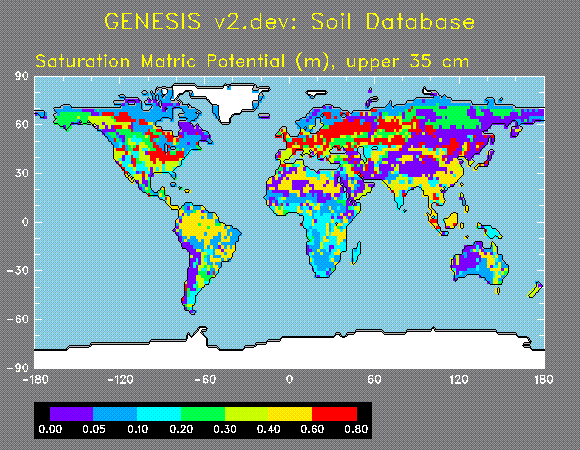
A six-layer soil model extends from the surface to 4.25 meter depth. Heat is diffused linearly, and soil moisture is diffused highly non-linearly (Clapp and Hornberger, 1986). Soil moisture is removed from each layer containing plant roots to supply the current rate of transpiration. Soil ice is predicted for each soil layer, with the latent heat of fusion and the amounts of ice and liquid accounted for explicitly. Surface runoff occurs if precipitation minus evaporation exceeds the maximum possible infiltration rate, and bottom gravitational drainage occurs out of the bottom layer. The combined runoff and drainage is globally integrated and transferred uniformly to the ocean at each time step, ignoring any details of ground hydrology or river flow. However, the runoff is aggregated on a regional basis for accounting purposes and compared with observed discharges of the world's major rivers. Prescribed soil texture and albedo properties are derived from a new 1 degree resolution database of sand/silt/clay fractions (Webb et.al., 1993), which allows vertical-column variations in soil properties.
In addition LSX and the soil model include the following hydrologic processes:

Soil Microbial Chemistry Model
Ray Lassiter and Luis Suarez at the EPA (ERL, Athens, GA) have developed a new model of soil microbial processes, including the production and consumption of greenhouse gases by biologic activity within the soil. The equations describe what are believed to be the dominant processes controlling element cycling in soils, including both aerobic and anaerobic microbial transformations. These kinetic equations predict production and consumption of oxidized and reduced chemical species as a function of the concentrations of oxidants, reductants, soil moisture and temperature. Quantities are distributed vertically by a soil chemistry transport model as described below, and gases and liquid water are exchanged with the atmosphere at the soil surface. The fundamental supply of organic material is the litter layer at the soil surface governed by the LSX model.
An important feature of the soil microbial model is the movement of chemical species vertically in the soil column, both by gaseous diffusion and moisture advection as a solute. This chemical transport capability is also available for other uses, such as the tracking of passive tracers such as radon within the soil. The transport mechanisms include:
The use of a prognostic total mass concentration avoids potential problems of zero capacities for gas and liquid when soil layers become saturated or entirely frozen. The model assumes that 100% of all species are rejected by soil ice. As well as the chemically active species in the soil microbial model, the major atmospheric constituents are included explicitly (N2, O2, Ar, CO2, Ne) for full future generality (e.g. soil sources and sinks of N2), and also to allow explicit calculation of the air pressure in each soil layer. T31 (3.75 degrees latitude and longitude) and vertical 18 levels.
12/8/97